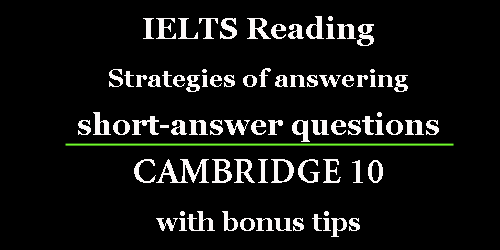IELTS Reading: the best way to answer short-answer questions
In IELTS Reading, the short-answer question is a very common question and it is one of those questions where you can easily save enough time. Time-saving in IELTS Reading can make a magic difference in your expected score. This post will focus on this question and show you some of the best techniques which you can apply to this question-type and get benefited.

A short-answer question is a conditional question, which is generally given as a singular open question or as fill-in-the-blanks. In this type of question, you are given questions containing a special condition that you need to follow to write the answer. The conditions may be:
Write NO MORE THAN THREE WORDS Or, Write ONE WORD ONLY Or, Write TWO WORDS AND/ OR A NUMBER Or, Write A NUMBER ONLY.
So, you must maintain the condition as it is in the question. If you fail to do so, your answer will be taken as WRONG ANSWER and you will be penalized. To explain, if you are given the condition of writing ONE WORD ONLY, you must write one word; you cannot write two or three words for this answer.
We should take a look at some questions of this type.
In your CAMBRIDGE 10, READING TEST 1, please open on page 19. Here, you will find questions 6-8 which are short-answer questions. As you can see, there is a condition for you to answer these questions. The condition is Choose ONE WORD ONLY from the passage for each answer. So, you must follow this instruction.
Here is the first question.
6. Which part of some step-wells provided shade for people?
If you scan this question, you will find some important keywords/ phrases which will surely guide you to the answer. The keywords/ phrases are Which part and provided shade.
So, we must look for some lines where we can find words/ phrases close to or synonymous with these words/ phrases. Here, the word “shade” gives us the hint that the answer has a close relation to the sun’s heat and protection from it.
Now, skim the passage carefully. In the fourth paragraph, you can find your answer in lines 6-7. It says, “they also included pavellions that sheltered visitors from the relentless heat.”
The part which provided shade is pavellions. The condition for writing the answer is ONE WORD ONLY. So, in the answer sheet, we have to write pavellions.
In this way, we can find all the answers and write them by maintaining the instruction or condition.
7. What type of serious climate event, which took place in southern Rajasthan, is mentioned in the article?
Clues: The keywords/ phrases for this question are serious climate event and southern Rajasthan.
Keep reading from where you’ve found the last answer (paragraph 4). Don’t go back. You won’t find the answer there. At the same time, think about serious climate events (earthquake, flood, volcanic eruption, drought etc.). In Paragraph 5, lines 9-10, says, “southern Rajasthan suffered an eight-year drought between 1996 and 2004.”
So, the answer is drought.
8. Who are frequent visitors to stepwells nowadays?
Clues: The keywords/ phrases for this question are frequent visitors and nowadays.
Keep reading from where you’ve found the last answer. The last paragraph starts with a word “Today” which is synonymous to nowadays. Keep reading. In line 7, it says, “Tourists flock to wells in far-flung corners of northwestern India….. … . ..”.
It means that nowadays the frequent visitors to stepwells are tourists.
So, the answer is tourists.
The answers to questions 6-8:
- pavellions
- drought
- tourists
Now, you can try some other short-answer questions from other Cambridge IELTS books.
BONUS TIP:
You do not need to read every single detail of a paragraph. Just focus on the question and read according to the questions. Try to match the keywords/ phrases of the questions with the passage. Practice the SKIMMING technique to make yourself more comfortable with different question types.
6 IELTS Preparation Tips for Reading Section
IELTS Reading: 10 steps which helped me to score 8.0 in Reading
Strategy for IELTS Reading: TRUE, FALSE, NOT GIVEN or YES, NO, NOT GIVEN




I think this website is helpful to learn more reading techniques as well as Graphs and Charts. I particularly like all of the posts related to reading. I suggest all of them to subscribe this website.
Thank you a lot for the review. If you have any queries, make some comments here about them too! I’ll be in touch.
Hi admin,
I have a doubt in this type of question. I came across few such questions in my IELTS exam. The criteria was “No more than THREE words”. In one such question there was a passage with the answer like this “……a White Badge…….” . So here do i need to write just “WHITE BADGE” or “A WHITE BADGE”. I had 10 such questions today in my real IELTS Exam and it really confused me. And i fear though i have found out the right answer for all the questions, i might loose just by adding “A”. Please your response is much appreciated and it can help many who are following you. Thanks in advance!
No! you won’t lose a mark for this. As the instruction says NO MORE THAN THREE WORDS, you have done right. A WHITE BADGE contains three words. So, you will get your mark. Don’t worry about it at all.
Try to read other posts as well. Your comments are highly appreciated.
I want to take every form contained in Cambridge books separately. How to find out short answer questions in these books to do. I find it difficult. Please help